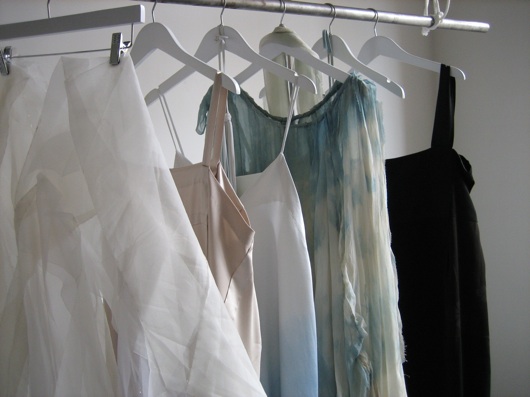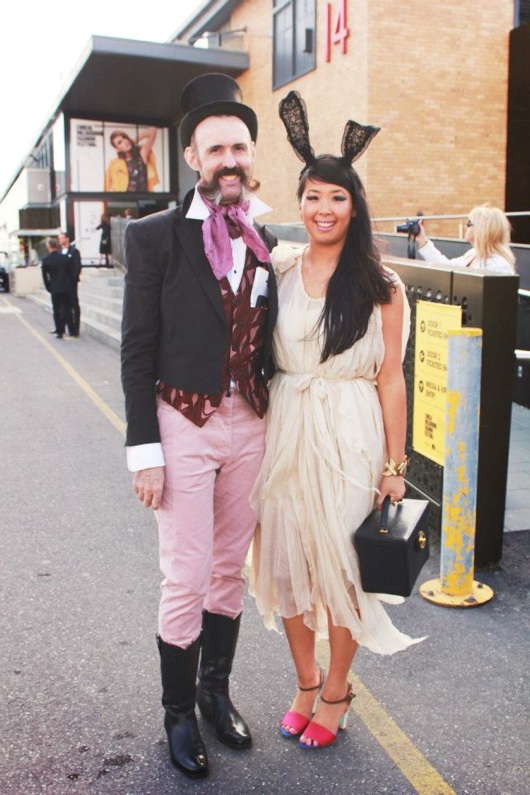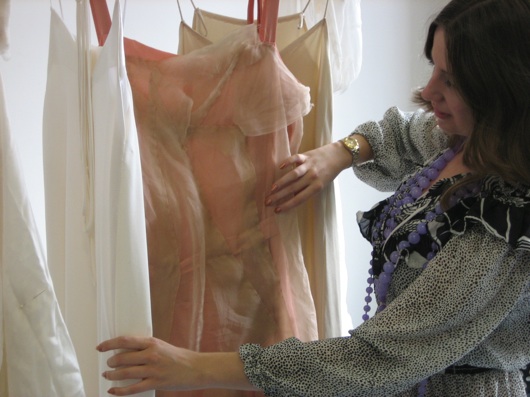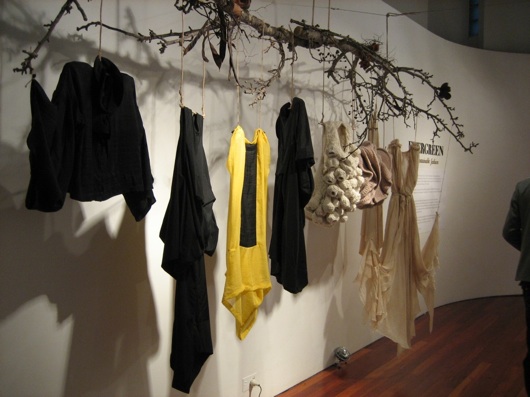Eco-Friendly Practice: Georgia McCorkill
By Phoebe Miller The pitfalls of fast fashion have rightly come under the spotlight in recent years, namely the effect on designers who struggle to compete with cheap product mass produced offshore and the impact on the environment. This month, we caught up with a local designer who's striving to make a positive impact with her work.
Georgia McCorkill's The Red Carpet Project is a design driven collaboration between designers, celebrities, stylists and publicists that uses the captivating properties of the fashion worn on the red carpet to raise awareness of environmental problems faced by the fashion industry. The project forms part of a PhD in Architecture and Design that Georgia is undertaking at RMIT University.
 Garments featured in The Front Row Project at LMFF 2012
Garments featured in The Front Row Project at LMFF 2012
What do you do/ design/ make? I design special occasion dresses that are informed by principles of design for sustainability. I find situations where the dresses will come to public notice, be it a red carpet event, a wedding, the front row of a fashion parade or on the catwalk itself, and then I engage participants involved with these events such as actresses, publicists and the like in order to make a project happen.
The interesting thing about what I do is that my work attracts praise for making sustainable fashion appeal to a popular audience through its pleasing aesthetic, yet it’s not at this point a commercial endeavor, it’s a creative activist practice.
 Oscars dress design shortlisted for Suzy Amis Cameron’s Red Carpet Green Dress competition
Oscars dress design shortlisted for Suzy Amis Cameron’s Red Carpet Green Dress competition
How do you approach sustainability and environmental awareness in your creative practice? The starting point for my designs is the idea that a special occasion dress is often only worn once, therefore its requirements for durability are minimal.
Current approaches to design for sustainability tend to focus on employing a range of design strategies as appropriate to the situation, such as recycling, re-use, design for disassembly, etc. I pretty much work within this framework, and try to constantly evolve new iterations of these strategies that I think are more innovative and better than the last. For instance, earlier work has focused on the use of natural plant dyes as well as upcycling fabric remnants. I continue to do these things, but my latest work has been more focused around designing dresses so that they can be disassembled and re fitted, thus facilitating sharing between wearers.
 Fair@Square Fair Fashion Parade. Photography by Chealse Vo.
Fair@Square Fair Fashion Parade. Photography by Chealse Vo.
Can you tell me about one or two of your favourite projects that showcase this approach best? My most recent project was called “The Front Row”. I was interested in showcasing a model of fashion whereby the dresses can be shared, with the designer acting as a moderator and custodian.
The similarities between the celebrities who walk the red carpet and the fashion people who occupy the front row of the fashion parade inspired me to use the L’Oreal Melbourne Fashion Festival as a setting for the project. As part of the LMFF Cultural Program I created a range of dresses that were worn by people attending the fashion parades throughout the festival. The pieces were returned to me after wearing, and I made alterations such as dyeing or re-styling so that another person could wear the same piece again to a new event. I ran the project from a pop up studio space that was open to the public and it was a manic but really fun three weeks of activity.
 Lisa Teh from Couturing (right) a creations for The Front Row, with Richard Nylon Image by Wanda Chin for Couturing
Lisa Teh from Couturing (right) a creations for The Front Row, with Richard Nylon Image by Wanda Chin for Couturing
 Lady Melbourne perusing Georgia's The Front Row collection
Lady Melbourne perusing Georgia's The Front Row collection
How and/ or where do you source your materials? I source remnants from bridal couture designers; the spaces that surround a pattern piece when it is cut out. These fabrics are of exceptional quality and ideal for processes such as dyeing. The odd shapes have come to determine many aspects of how I make the dresses, and I have developed a way of working with the remnant shapes in all their oddity without having to tame them too much.
Other fabrics might come from remnants from second hand kimonos, or fabric store remnants at the ends of rolls.
One issue when you talk about materials is that sustainability tends to focus on materials usage and issues such as recycling or organics. It’s a challenge to think beyond these things and imagine all of the other ways that fashion could be that embrace fashion not just as material production but as a symbolic cultural phenomenon.
 Evergreen: fresh sustainable fashion exhibition at Object From left to right: Holly McQuillan, Julia Knupfer and Georgia McCorkill
Evergreen: fresh sustainable fashion exhibition at Object From left to right: Holly McQuillan, Julia Knupfer and Georgia McCorkill
What challenges have you come up against in trying to make your practice sustainable and how did you overcome them? It wasn’t as though I had an unsustainable practice and then I tried to make it sustainable. It started with an idea of how I wanted this practice to be and then I worked towards that. The real world nature of the projects means that what you would ideally like to do is not always possible, because everyone involved has to be satisfied that my designs will fulfil the purpose they have imagined for it.
I’ve come to enjoy though exploring the possibilities for this more conciliatory approach to design, because ordinarily as a fashion designer you are encouraged to see yourself in a much more authoritarian role.
Is there anything you’d like to do or learn to further increase the environmental sustainability of your creative practice? My future aspirations are to continue to use design in a spirit of activism to encourage innovation in the ways we make, consume and relate to clothes and fashion.
 Cheryl Lin donning a piece from The Front Row collection for the Business Chic Little Black Dress Project
Cheryl Lin donning a piece from The Front Row collection for the Business Chic Little Black Dress Project
Who inspires you? I’m really inspired by anyone who is challenging fashion not just from and aesthetic perspective but from a systematic and cultural point of view.
All images in this post courtesy of Georgia McCorkill and The Red Carpet Project, unless otherwise noted.
